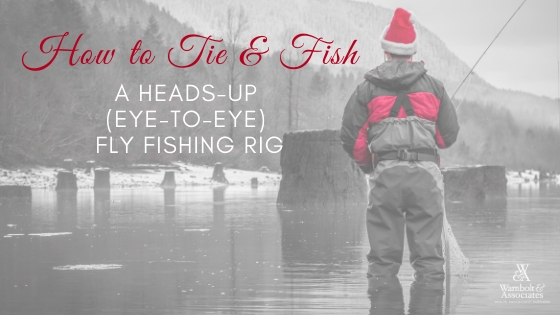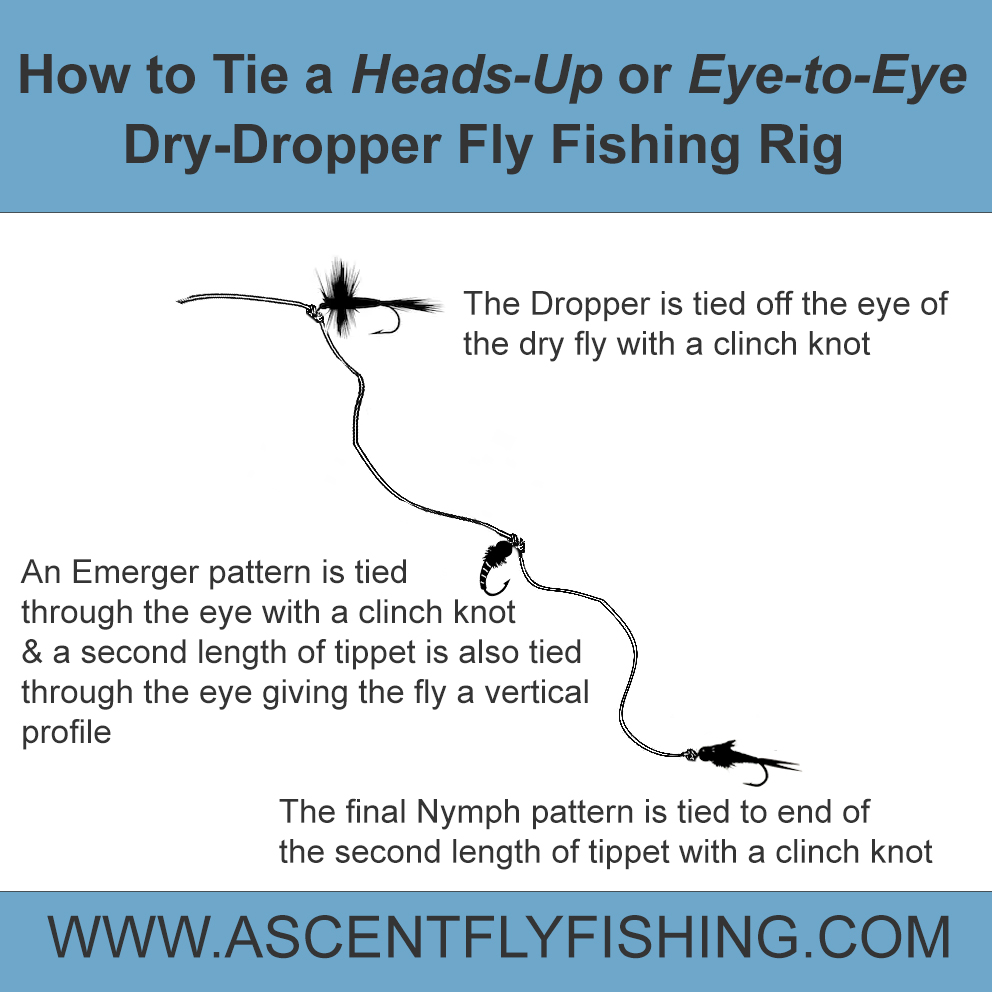The following content is part of our Fly of the Month Club. This article is written by Peter Stitcher from Ascent Fly Fishing.

I still remember the first time I saw someone tie on a dry fly with a nymph dropper hanging off the curve of the hook – I thought my head was going to explode! I was struck by the brilliance of being able to cover and fish multiple layers of the water column simultaneously with one multi-fly rig or to even cover multiple stages of a hatch all on one line (using an adult-dry fly on top, a wet emerger pattern fished mid column, and a nymph pattern fished deep off the end of the line). For many, this is the pinnacle of complex fishing rigs, but I suggest that we can do better, and with one slight alteration and going ‘heads up’ (or tying on our droppers eye-to-eye) we can make our dropper rigs exponentially more deadly and vastly improve our catch rate.
The benefits of attaching the tippet for dropper flies to the eye of the previous hook instead of the back of the hook are two-fold: 1 – Our flies gain a more realistic profile in the water column, and 2 – Hooks remain deeply set and bring more fish to hand.
Adult aquatic insects sit high on top of the water held aloft by their legs, and emerging insects are oriented vertically in the water column as they frantically swim towards the surface in their effort to hatch. No rig better matches these natural orientations than the heads-up or eye-to-eye rig. Tying droppers off of the eye of a dry fly will create a longer, higher floating dry fly and a more realistic and tantalizing emerger trailing beneath it.
The chief benefit of the heads-up or eye-to-eye rig is its sticking power and ability to hold onto fish until they are safely secured in your net. When droppers are tied in line, eye to hook bend, each subsequent fly has the ability to snag on the bottom of the river or a stick and apply a direct and perfectly angled pressure to dislodge the upstream hook from the mouth of the trout. Identical to the pressure applied to the curve of the hook with one’s forceps when releasing a fish, any pressure applied along a line of flies rigged eye to hook bend will work to pull the upstream flies from the mouth of the trout. When rigging flies eye to eye EVERY PRESSURE, whether from the bend of our rods or from a momentary snag along the bed of the river, will work to more deeply set and secure the hook into the lip of the trout.
The next time you are getting ready to tie up your dry-dropper or nymphing rig, tie your flies on eye-to-eye and get ready for an awesome day on the water and more fish in your net!
Interested in joining our Fly of the Month Club? Click here for more information.




Follow Us on LinkedIn
This commentary on this website reflects the personal opinions, viewpoints and analyses of the Wambolt & Associates employees providing such comments, and should not be regarded as a description of advisory services provided by Wambolt & Associates or performance returns of any Wambolt & Associates Investments client. The views reflected in the commentary are subject to change at any time without notice. Nothing on this website constitutes investment advice, performance data or any recommendation that any particular security, portfolio of securities, transaction or investment strategy is suitable for any specific person. Any mention of a particular security and related performance data is not a recommendation to buy or sell that security. Wambolt & Associates manages its clients’ accounts using a variety of investment techniques and strategies, which are not necessarily discussed in the commentary. Investments in securities involve the risk of loss. Past performance is no guarantee of future results.
Wambolt & Associates provides links for your convenience to websites produced by other providers or industry related material. Accessing websites through links directs you away from our website. Wambolt & Associates is not responsible for errors or omissions in the material on third party websites, and does not necessarily approve of or endorse the information provided. Users who gain access to third party websites may be subject to the copyright and other restrictions on use imposed by those providers and assume responsibility and risk from use of those websites.


